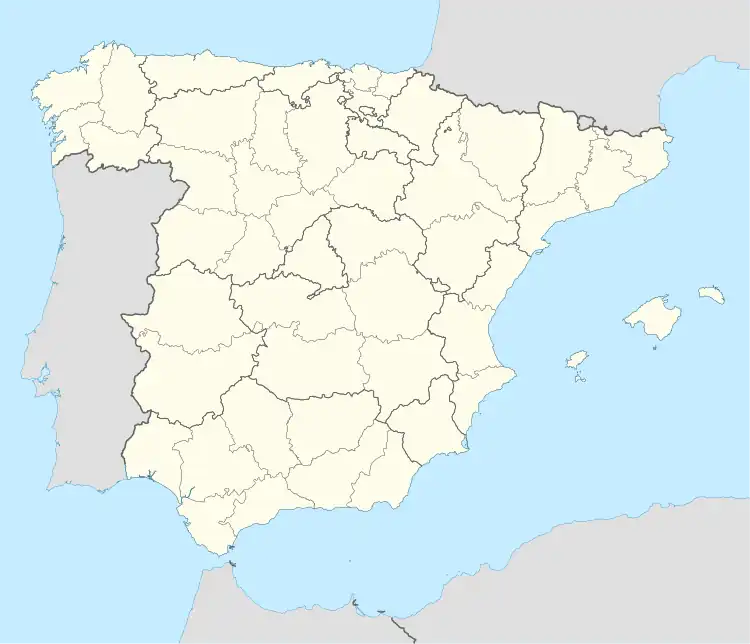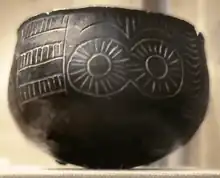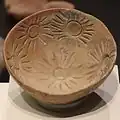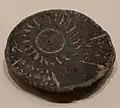 A model of the prehistoric town of Los Millares, with its walls. | |
 Shown within Spain | |
| Location | Santa Fe de Mondújar, Province of Almería, Andalusia, Spain |
|---|---|
| Coordinates | 36°57′53″N 02°31′20″W / 36.96472°N 2.52222°W |
| Type | Settlement |
| Area | 2 ha (4.9 acres) |
| History | |
| Periods | Chalcolithic |


Los Millares is a Chalcolithic occupation site 17 km north of Almería, in the municipality of Santa Fe de Mondújar, Andalucía, Spain. The complex was in use from the fourth millennium BC (c. 3000 BC) to the end of the third millennium BC (2000 BC) and probably supported somewhere around 1000 people.[1][2] It was discovered in 1891 during the construction of a railway. It was first excavated by Luis Siret in the succeeding years. Excavations are ongoing. Los Millares is the type site of the Chalcolithic Millaran culture.[3]
Site description
The site covers 2 hectares (4.9 acres) and comprises three concentric lines of stone walls, the outer ring the largest, running more than 200 meters (650 feet) with nineteen 'bastions' and a gate guarded by foreworks.[1] The road to the site is guarded by four smaller outlying stone forts.[1] There is an extensive cemetery of eighty passage grave tombs.[1] Radiocarbon dating has established that one wall collapsed and was rebuilt around 3025 BC.
A cluster of simple dwellings lay inside the walls as well as one large building containing evidence of copper smelting. Pottery excavated from the site included plain and decorated wares including symbolkeramik bowls bearing oculus motifs. Similar designs appear on various carved stone idols found at the site. Although primarily farmers, the inhabitants of Los Millares had crucially also learned metal working, especially the smelting and forming of copper, and the site is considered highly important in understanding the transition from the Neolithic to the Bronze Age.[4] The Millaran culture eventually came to dominate the Iberian peninsula.
The population of Los Millares has been estimated at approximately 1000 in the timeframe 3200–2300 BC. The labor involved in its construction, the large volume of stones used, its geometric characteristics and sophisticated design all indicate multiple functionality, including defense and power.[2][5]
Relationship to other prehistoric cultures
Los Millares participated in the continental trends of Megalithism and the Beaker culture . Analysis of occupation material and grave goods from the Los Millares cemetery of 70 tholos tombs with port-hole slabs has led archaeologists to suggest that the people who lived at Los Millares were part of a stratified, unequal society which was often at war with its neighbors . The Los Millares civilisation was replaced circa 1800 BC, with the arrival of Bronze by the El Argar civilisation, whose successor culture is embodied in the contemporary culture of Vila Nova de São Pedro in nearby Portugal.
Other Iberian settlements in this region of a similar age to Los Millares include the settlement of Los Silillos and Neolithic finds at Cabrera.[6]
Similarities between Los Millares architecture and the step pyramid at Monte d'Accoddi in Sardinia have been noticed .
Conservation and access
The site has been protected by a heritage designation, currently Bien de Interés Cultural, since 1931.
There is an interpretation centre at the site itself. Some finds are displayed at the National Archaeological Museum in Madrid, and others at the Museum of Almería.
Gallery

See also
- Prehistoric Europe
- Chalcolithic Europe
- Megalith, including other European megalithic cultures
References
- 1 2 3 4 Cunliffe, Barry (2008). Europe Between the Oceans, 9000 BC-AD 1000. p. 144.
- 1 2 Peregrine, Peter Neal; Ember, Melvin, eds. (October 1, 2001). Encyclopedia of Prehistory. Vol. 4 : Europe. New York: Springer. ISBN 0306462583. OCLC 60343445.
{{cite encyclopedia}}: Missing or empty|title=(help) - ↑ "History of Europe - The Copper Age". Britannica.com.
- ↑ "The village of Millares in the Almeria province, Andalucía, Southern Spain". Andalucia.com. 7 June 2011. Retrieved 2015-06-13.
- ↑ "Los Millares - Chalcolithic Site of Los Millares". Archaeology.about.com. Archived from the original on 2017-01-07. Retrieved 2015-06-13.
- ↑ "Los Silillos - Ancient Village or Settlement in Spain in Andalucía". Megalithic.co.uk. Retrieved 2015-06-13.




_01.jpg.webp)






